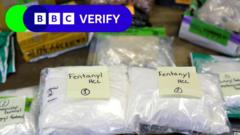Now, the details of fentanyl smuggling into the U.S. illustrate the involvement of various countries and suggest significant challenges in addressing the opioid crisis.
Fentanyl, a synthetic opioid known for its potency, is primarily linked to a growing public health crisis in the U.S. The drug accounted for over 74,000 overdose deaths in 2023 alone, making it a top concern for health officials and policymakers. The U.S. government has laid much of the blame on international sources, particularly Chinese and Mexican entities involved in the production and smuggling of illegal substances.
Historically, the Trump administration imposed extensive tariffs on Chinese goods, asserting that China was failing to curtail the export of fentanyl precursors. In retaliation, Beijing imposed its own tariffs, marking a burgeoning trade conflict amid a backdrop of drug policy enforcement. While China has been accused of being the main supplier of chemicals necessary for fentanyl's production, much of the completed drug enters the U.S. through Mexico. As per the U.S. Customs and Border Protection (CBP), approximately 98% of fentanyl seized this year was intercepted at the southwest border.
Mexican criminal organizations, notably the Sinaloa Cartel, are pivotal players in the fentanyl trade. These groups source precursor chemicals from China, process them in clandestine labs in Mexico, and subsequently smuggle the finished product into the U.S. Law enforcement has struggled to combat this widespread trafficking due to the sophisticated methods traffickers employ, including concealment within legitimate shipments and utilizing various international routes.
In response to U.S. accusations, Mexican officials, including President Sheinbaum, have rejected claims of collusion with drug cartels, branding them as slanderous. Despite this, a recent major seizure of fentanyl by Mexican authorities—approximately 20 million doses—demonstrates an acknowledgment of the pressing crisis.
Meanwhile, the Chinese government insists that it has enacted strict drug laws and asserts that the U.S. must take responsibility for its own issues surrounding fentanyl. Despite preceding efforts by China to control the sale of many chemicals used in fentanyl production, reports indicate a loophole-crammed market where illegal sales continue through encrypted channels and cryptocurrency.
Alongside China and Mexico, Canada has also emerged as a focal point in the trafficking narrative. Although only 0.2% of fentanyl seizures in the U.S. occur at the Canadian border, evidence has surfaced indicating organized crime groups in Canada are increasingly involved in fentanyl production. They have been importing necessary lab equipment and precursor chemicals from China, facilitating the cross-border trade with the U.S.
As the multifaceted crisis progresses, Canada has pledged financial resources to combat the influx of fentanyl and bolster border security. However, despite differing roles in the trafficking of fentanyl, all three nations face the collective challenge of finding effective solutions to curb the fentanyl epidemic, emphasizing the need for collaboration and robust enforcement strategies.
Fentanyl, a synthetic opioid known for its potency, is primarily linked to a growing public health crisis in the U.S. The drug accounted for over 74,000 overdose deaths in 2023 alone, making it a top concern for health officials and policymakers. The U.S. government has laid much of the blame on international sources, particularly Chinese and Mexican entities involved in the production and smuggling of illegal substances.
Historically, the Trump administration imposed extensive tariffs on Chinese goods, asserting that China was failing to curtail the export of fentanyl precursors. In retaliation, Beijing imposed its own tariffs, marking a burgeoning trade conflict amid a backdrop of drug policy enforcement. While China has been accused of being the main supplier of chemicals necessary for fentanyl's production, much of the completed drug enters the U.S. through Mexico. As per the U.S. Customs and Border Protection (CBP), approximately 98% of fentanyl seized this year was intercepted at the southwest border.
Mexican criminal organizations, notably the Sinaloa Cartel, are pivotal players in the fentanyl trade. These groups source precursor chemicals from China, process them in clandestine labs in Mexico, and subsequently smuggle the finished product into the U.S. Law enforcement has struggled to combat this widespread trafficking due to the sophisticated methods traffickers employ, including concealment within legitimate shipments and utilizing various international routes.
In response to U.S. accusations, Mexican officials, including President Sheinbaum, have rejected claims of collusion with drug cartels, branding them as slanderous. Despite this, a recent major seizure of fentanyl by Mexican authorities—approximately 20 million doses—demonstrates an acknowledgment of the pressing crisis.
Meanwhile, the Chinese government insists that it has enacted strict drug laws and asserts that the U.S. must take responsibility for its own issues surrounding fentanyl. Despite preceding efforts by China to control the sale of many chemicals used in fentanyl production, reports indicate a loophole-crammed market where illegal sales continue through encrypted channels and cryptocurrency.
Alongside China and Mexico, Canada has also emerged as a focal point in the trafficking narrative. Although only 0.2% of fentanyl seizures in the U.S. occur at the Canadian border, evidence has surfaced indicating organized crime groups in Canada are increasingly involved in fentanyl production. They have been importing necessary lab equipment and precursor chemicals from China, facilitating the cross-border trade with the U.S.
As the multifaceted crisis progresses, Canada has pledged financial resources to combat the influx of fentanyl and bolster border security. However, despite differing roles in the trafficking of fentanyl, all three nations face the collective challenge of finding effective solutions to curb the fentanyl epidemic, emphasizing the need for collaboration and robust enforcement strategies.




















